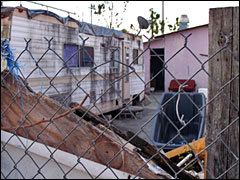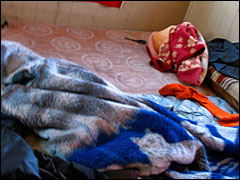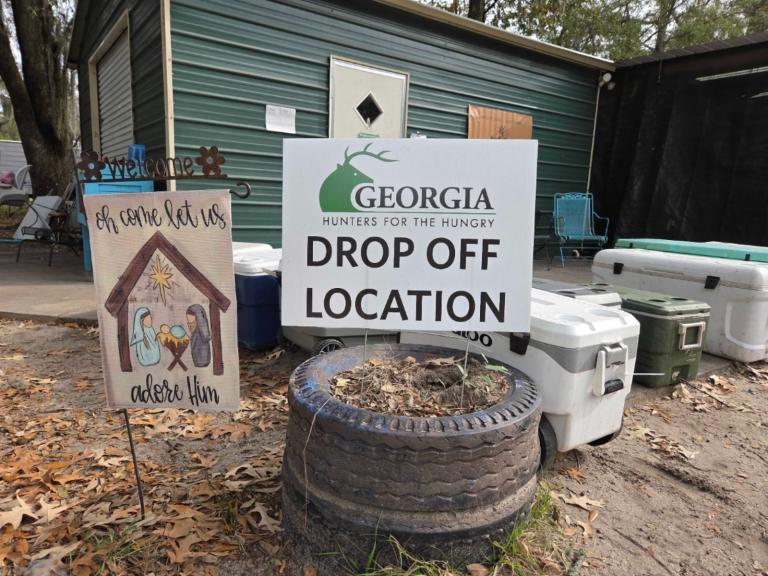Note: Last week, I visited Immokalee, Fla., with nine other food-politics writers and activists. We were there to check out conditions in the area where 90 percent of winter tomatoes consumed in the U.S. originate. Part I of my diary is here.
———
Update [2009-3-13 15:3:13 by Tom Philpott]: After refusing for two years, Florida Gov. Charlie Crist has agreed to meet with the Coalition of Immokalee Workers, the Fort Myers News Press reports.
———
In the area around Fort Myers, Fla., the collapsed real-estate market has plunged the economy into depression. Home prices have fallen 80 percent from peaks in some exburbs, entire blocks of houses lie empty, and families are queuing up at church breadlines in increasing number, The New York Times recently reported.

About an hour inland in Immokalee, my fellow food-justice delegates and I witnessed a much different real-estate scene. Walking through town with Coalition of Immokalee Workers leader Lucas Benitez, we saw very little apparent vacancy in the dense thicket of rusted trailers and dilapidated shacks that make up most of the farmworker housing.
As we toured Immokalee on this cool, sunny March morning, residents milled about here and there. Because of the real-estate meltdown in places like Fort Myers, construction has stalled. The building boom had drawn thousands of tomato pickers to the coast for higher-paid construction work. The bust has propelled them back to the tomato fields — where a worker glut idles about a quarter of the workforce every day, Benitez estimates.
If the labor market has soured in Immokalee, rents have held up just fine. According to Benitez, workers pay $800 per week for the largest two-room trailers and shacks available. That’s $3,200 a month, for a space that looks like it might comfortably fit a family. That’s a rate that might make a Manhattan landlord grin. The dwellings are unheated and uninsulated — no fun during chilly winter nights.
How do farmworkers, who make $50 on a good day, manage? As the old marketing slogan goes, volume, volume, volume. In order to bring rent to a manageable level, they often live 16 people per structure. That makes rent about $50 per person per week.
That’s how the people who pick 90 percent of winter tomatoes consumed in the United States live.
At one point, very near the central parking lot where trucks pick up workers, Lucas pointed us to a particularly run-down and extra-small trailer, which stood behind a crumbling fence. That, he said, is where he lived during his years as a tomato picker. He lived there with four other workers. Unlike most housing in Immokalee, the place had no running water — residents used an outhouse. As we groped for our cameras to record an image of the spot — still in use as housing today — someone asked him what it was like living there.

“I kind of liked it,” he said. “It’s a short walk to the parking lot, and there’s a little yard to hang out in after work.”
As we made our way through town, Benitez asked around for someone who would be willing to let us inside a home for a look. At this point, we were a large crew — not just the 10 delegates, but also a half-dozen journalists from nearby outlets and several CIW folks. I would be horrified to invite nearly two dozen strangers, many of them toting cameras, into my home without much notice.
Finally, we found someone who would. It was a small two-room trailer — much smaller than the ones that go for $800. This one housed seven men, and ran $400 per week.
It’s hard to describe what we saw their without lapsing into maudlin Victorian-era rhetoric about “squalor.” It was an intense experience.
You walk into a 12″ by 12″ room that includes the kitchen on the far right. The floor is plywood, the walls particle board. There’s a small four-burner stove, a sink, a surprisingly new-looking fridge, and a small counter. Above, there’s a shelf for dry-food storage, with several bags of Maseca instant-tortilla mix. (As I’ve written before, Maseca is the company responsible for industrializing Mexican tortilla production; it’s part-owned by U.S. grain-trading giant Archer Daniels Midland.)
The rest of the room is dominated by three slender, well-worn mattresses, so close together they touch. No sheets or pillows — the men bed down in cheap sleeping bags. They keep their belongings stuffed in bags near the heads of their mattresses. A few empty milk crates sit upside-down in the kitchen area — the only furniture in the house.
At the end of the room opposite the kitchen, a slender hallway leads to the other room. Midway down the hall, on the right, a door opens to the bathroom. A torn piece of black plastic serves as the shower curtain; the toilet has no seat.

At the end of the lies the other room. It has just enough space to contain four beat-up mattresses — only one of them wasn’t a mattress, it was a box spring, its outer material ripped, exposing its wooden skeleton.
A smell hung over the dwelling: sweat, cheap food, dirty clothes — the smell of hardworking people crammed together.
The experience of being inside drove home a point that I had known intellectually but now understand viscerally: the people responsible for generating food for the richest nation in the world live in poverty.
It drove home another point, too: Poor people generate immense wealth. Imagine the wealth these folks create up the food chain with the 32-pound buckets of tomatoes they harvest for 40 cents’ pay. Imagine the wealth they generate for the owners of these slapped-together trailers and shacks.
Lucas told us that a single family, the Blockers, owned most of the real estate in Immokalee. I later learned that the Blockers had been tussling for years with local authorities over the slum conditions of their dwellings. From what I saw, the Blockers were winning.
For good measure, the Blockers also own a discount furniture store in Immokalee. No one has to tell them that squeezing the poor is a lucrative metier.
After we left the dwelling, Benitez had something even grimmer to show us: the site where, a little more than a year ago, federal prosecutors shut down the latest slavery ring in Immokalee. In a now-empty lot of a teeming trailer park, Benitez pointed to the spot where a trailer had stood. Here’s how prosecutors described the situation, according to an account in the Fort Myers News-Press:
They made them [12 people] sleep in box trucks and shacks, charged them for food and showers, didn’t pay them for picking produce and beat them if they tried to leave.
On a fence outside the lot, we saw something rare in Immokalee but all-too common in south-central Florida: a for-sale sign. For a lot big enough, according to a comparison with an adjacent lot, to plunk down seven trailers, the asking price was $300,000. Not an unreasonable price, when you calculate how much you make each week off each trailer.
It’s easy to see, in a place where people are used to being squeezed on one side by literally penny-pinching tomato growers and the other by money-ravenous landlords, how slavery conditions can periodically rise up.
But our trip to Immokalee wasn’t just a lesson in crushing poverty. There was also hope. That evening, after a nice meal in the yard behind the CIW community center, we got to attend a community meeting. Nearly a hundred workers crowded into the center. Benitez addressed them with an easy rapport; good humor pervaded. They discussed a recent community-wide party that the CIW had hosted.
And then it was onto business: a protest outside the governor’s mansion scheduled for the following Monday. CIW was leading a workers’ contingent to confront Florida Gov. Charlie Crist about his refusal to meet with workers and his cavalier attitude toward slavery in the tomato fields.
Earlier that day, at a press conference, delegate and author Raj Patel called Crist’s office on a speaker phone, mock-earnestly trying to set up a meeting between the CIW and the governor. In a bit of low comedy that drew chortles from the crowd, the secretary declared that the governor was “in a meeting” and couldn’t come to the phone. She suggested that Patel write a letter to the governor formally requesting a meeting. When Patel responded that the CIW had been doing just that for 18 months, she sounded shocked.
Gourmet Magazine‘s excellent Barry Estabrook has written about Crist’s attitude. The governor has refused to speak out on the issue, instead directing a state ag official to do so. The results were unfortunate. The official told reporters:
Of course, I say any instance is too many, and any legitimate grower certainly does not engage in that activity. But you’re talking about maybe a case a year.
Estabrook summed the attitude like this: “A little slavery is okay, just not too much of it.”
Amid brutal conditions, the workers of Immokalee are slowly taking control of their situation. Over the past five years, the CIW has faced down some of the globe’s most powerful food companies: McDonald’s, Burger King (part-owned by Goldman Sachs), and Yum Brands (owner of Taco Bell).
They got those tomato-consuming giants to agree, kicking and screaming, to pay workers a penny more a pound for tomatoes, which would represent the first substantial raise for tomato pickers in decades.
The Florida Tomato Growers Exchange now refuses to pass that raise along. Given the CIW’s track record, I’d wager that the growers’ co-op will cave in over the next year — and that Crist will agree to meet with workers and crack down on modern-day slavery in his state.


